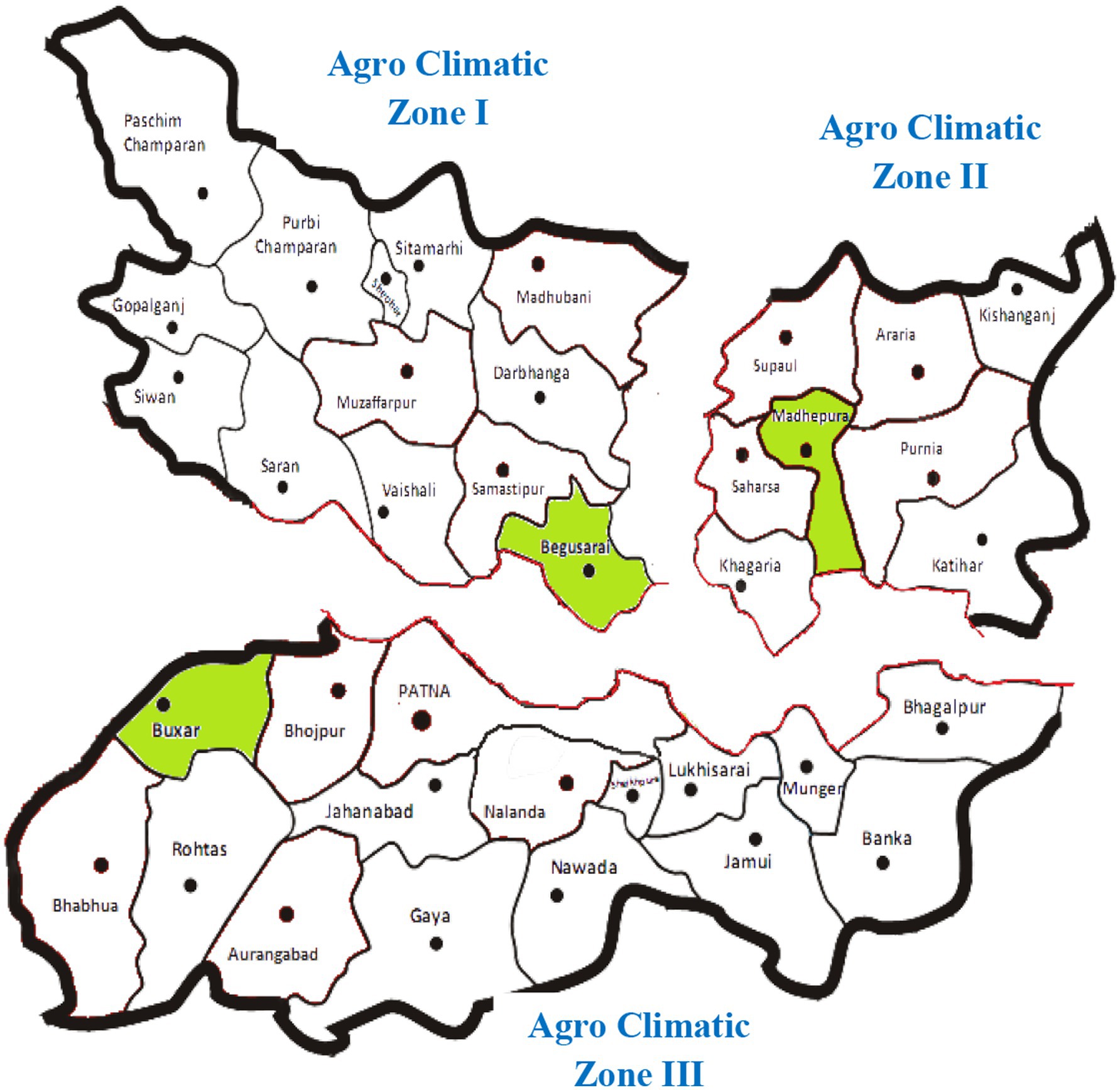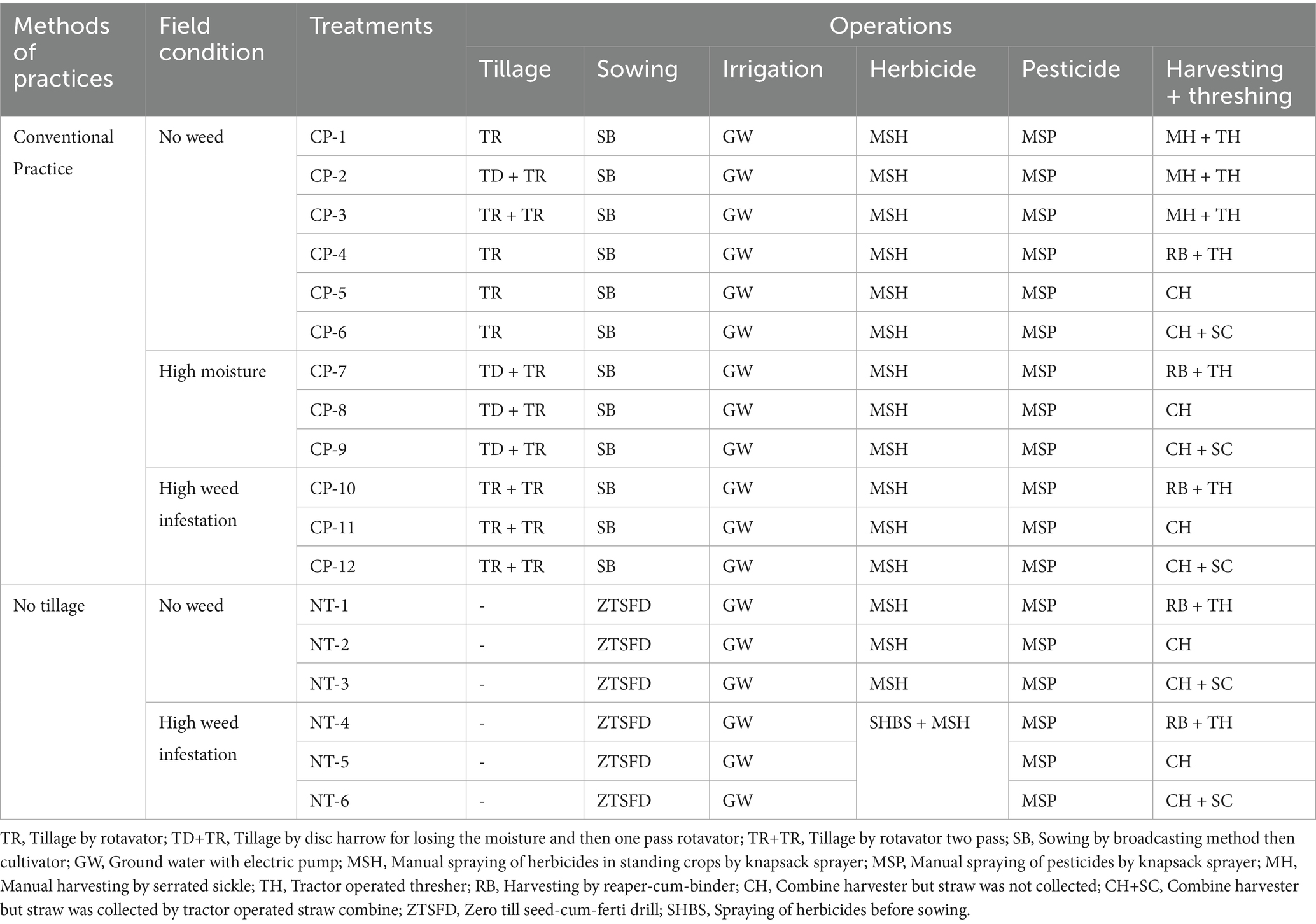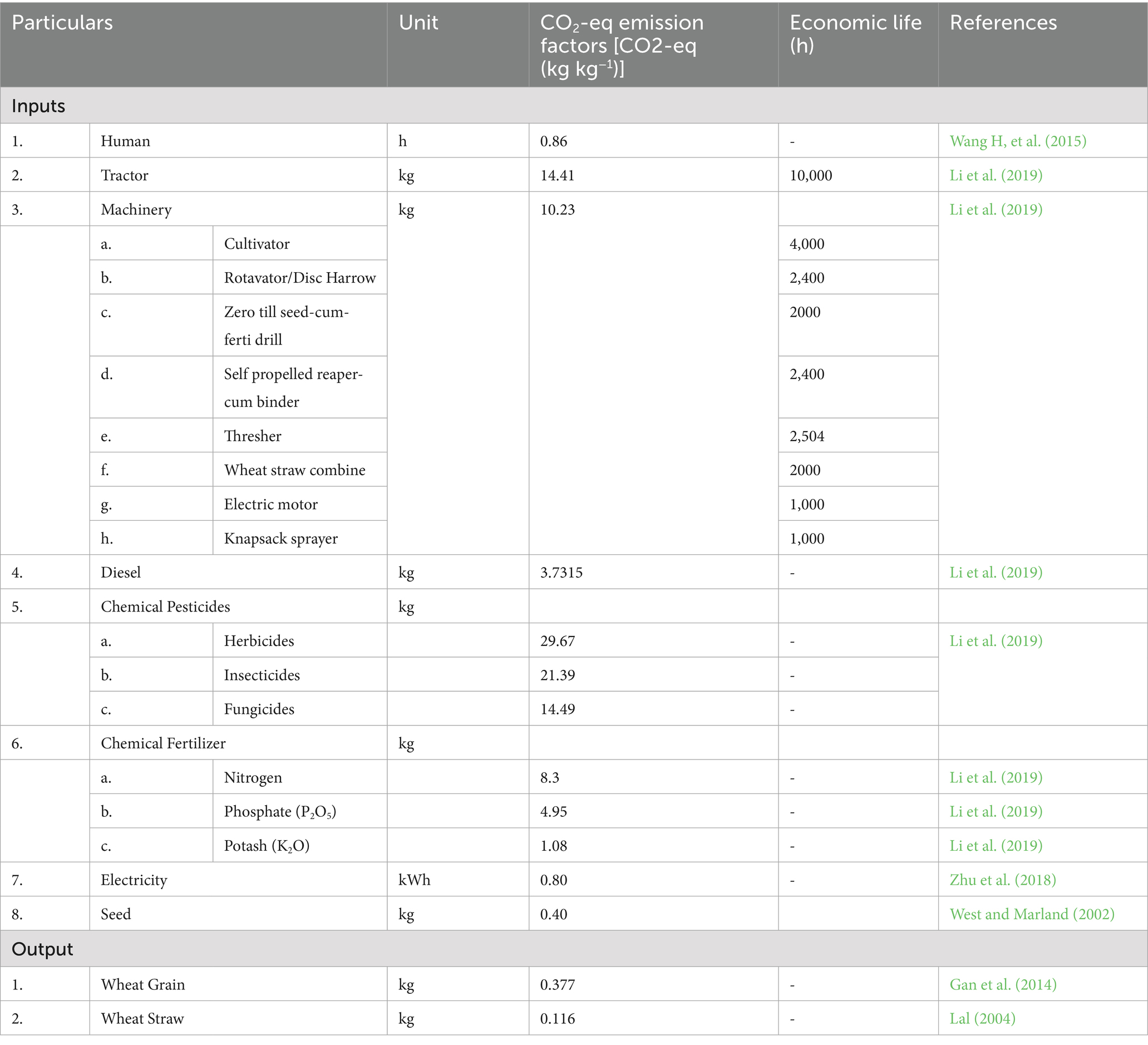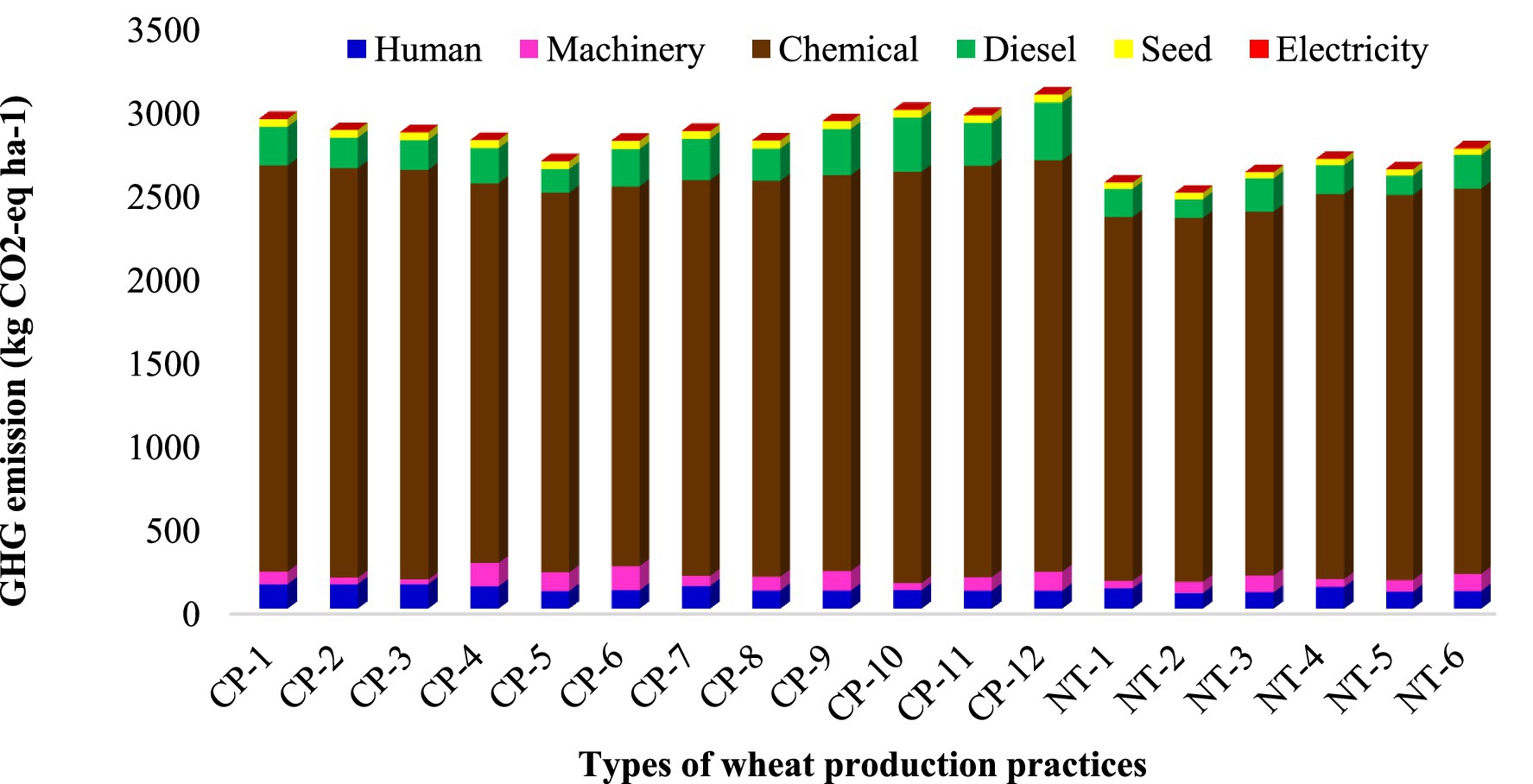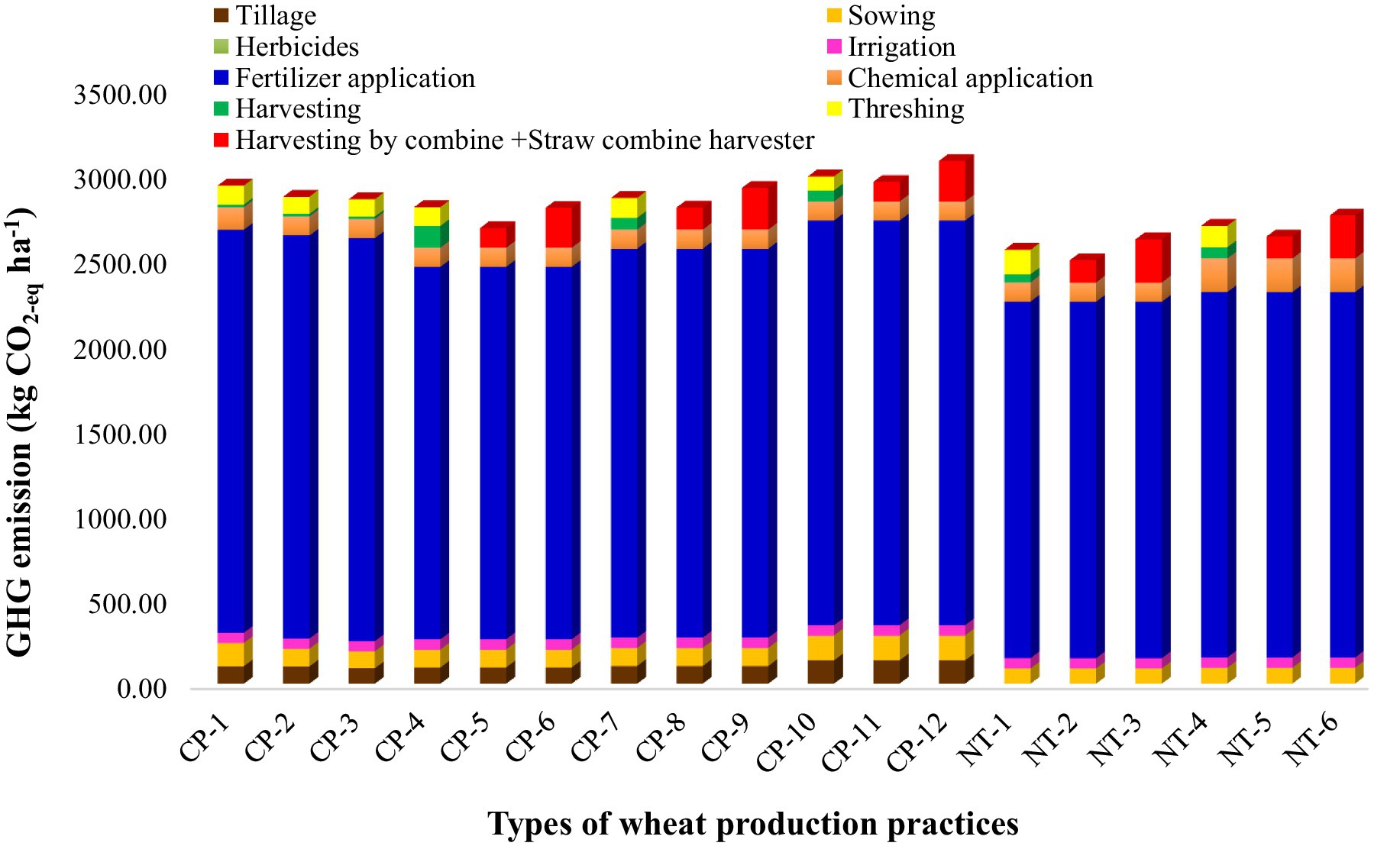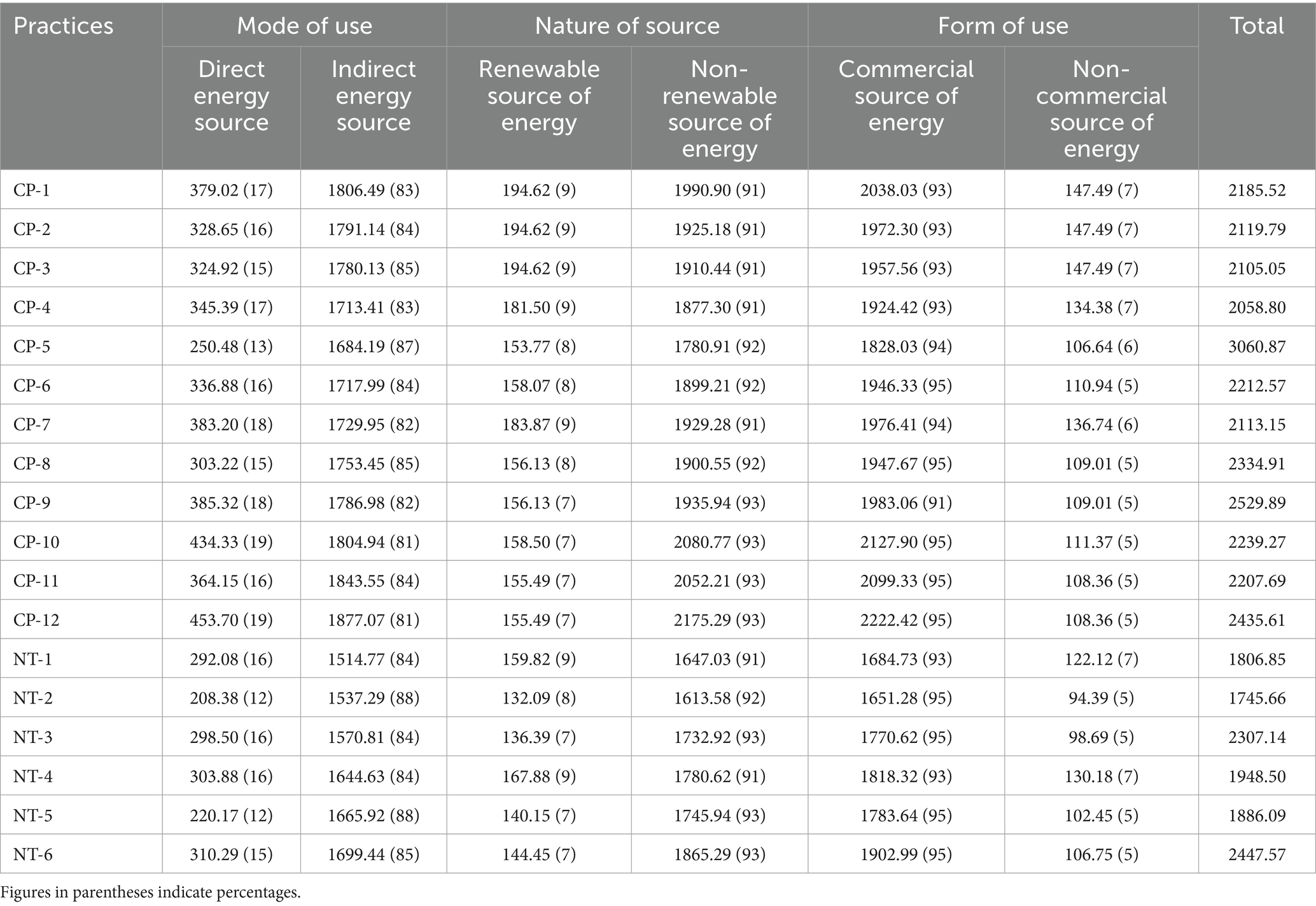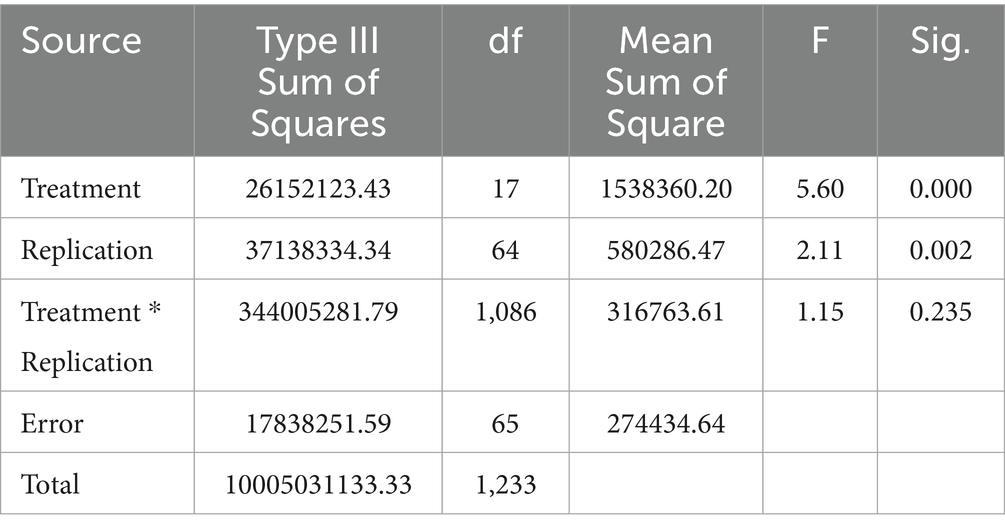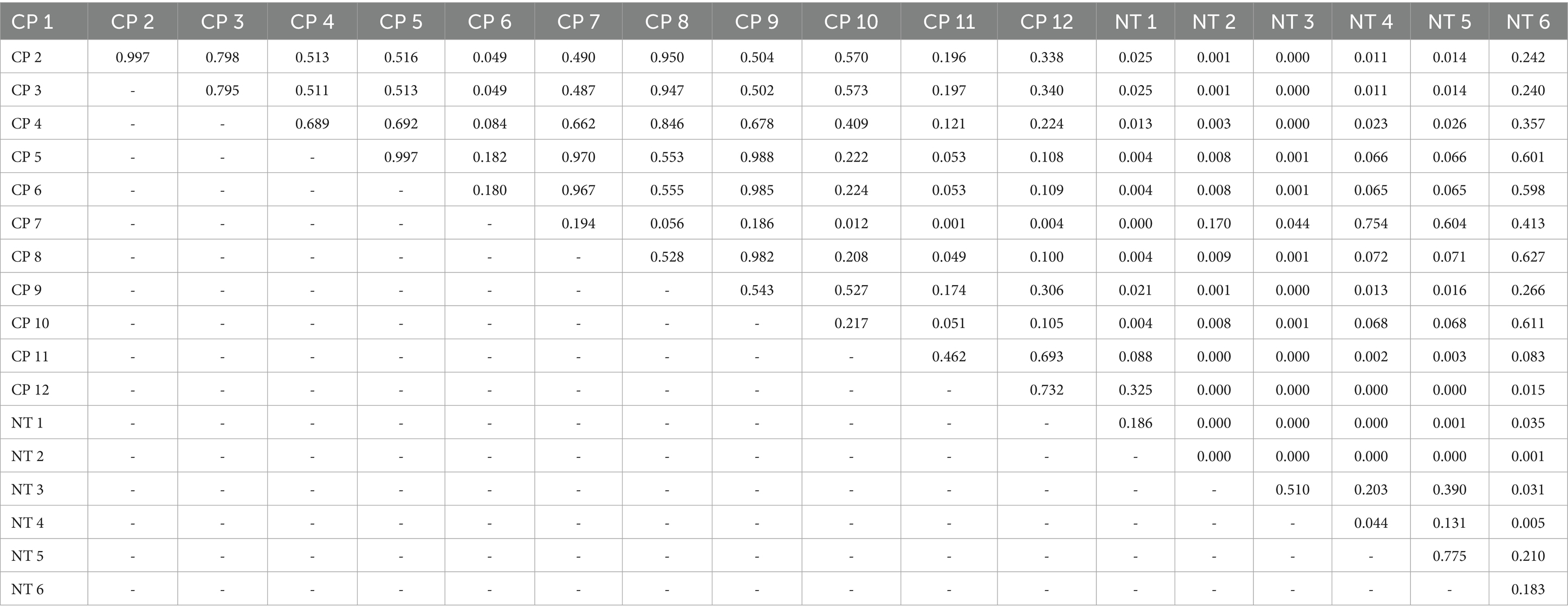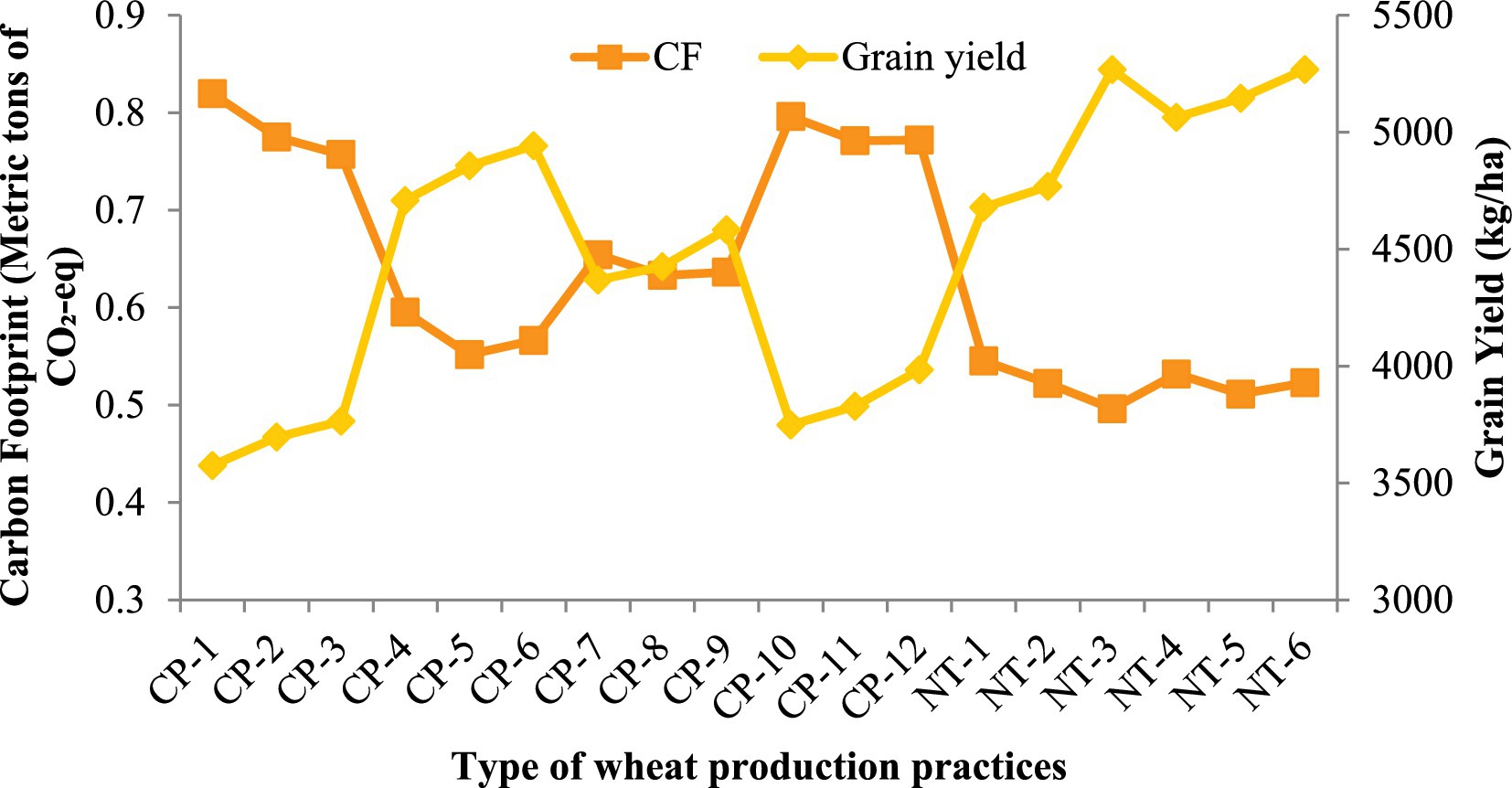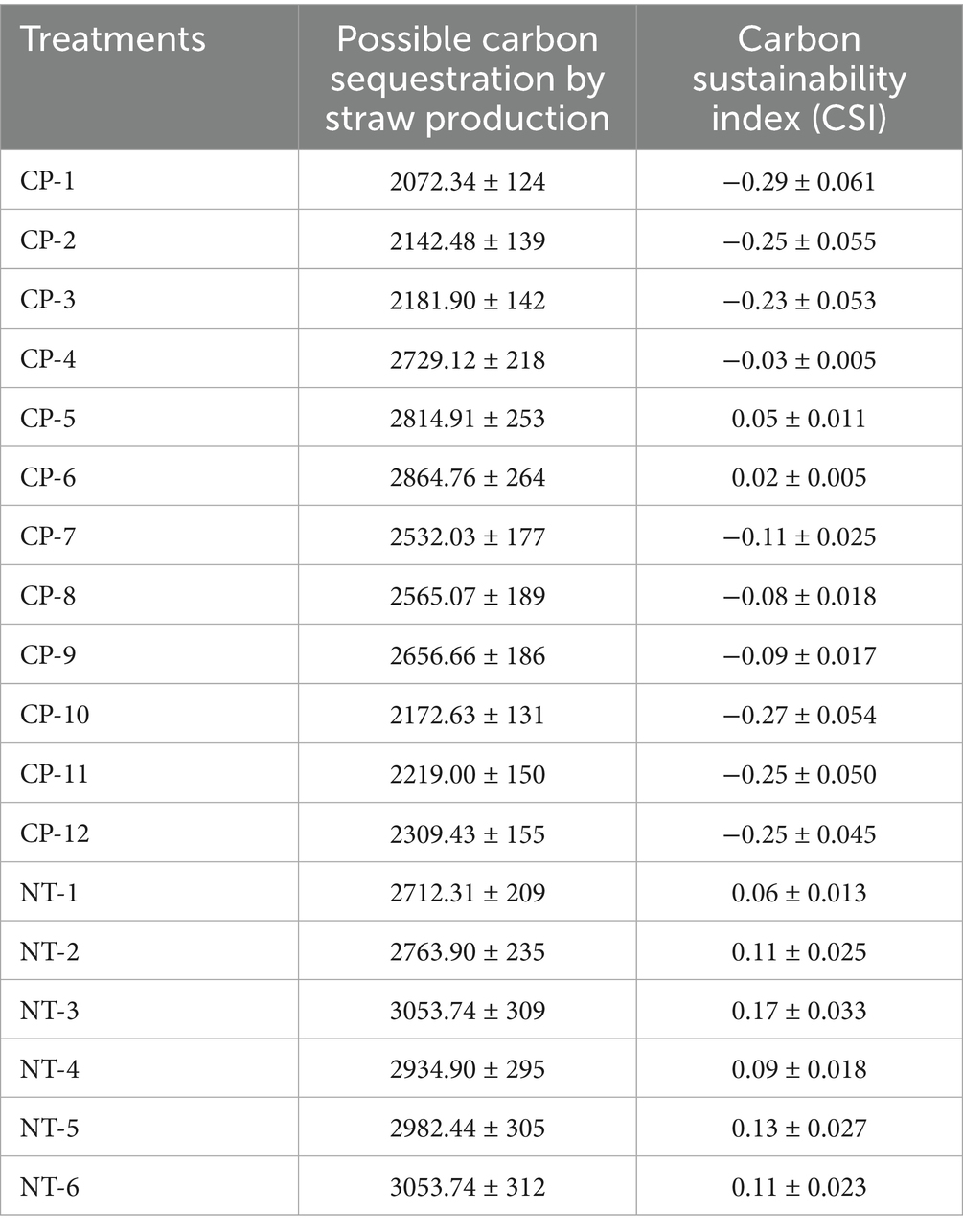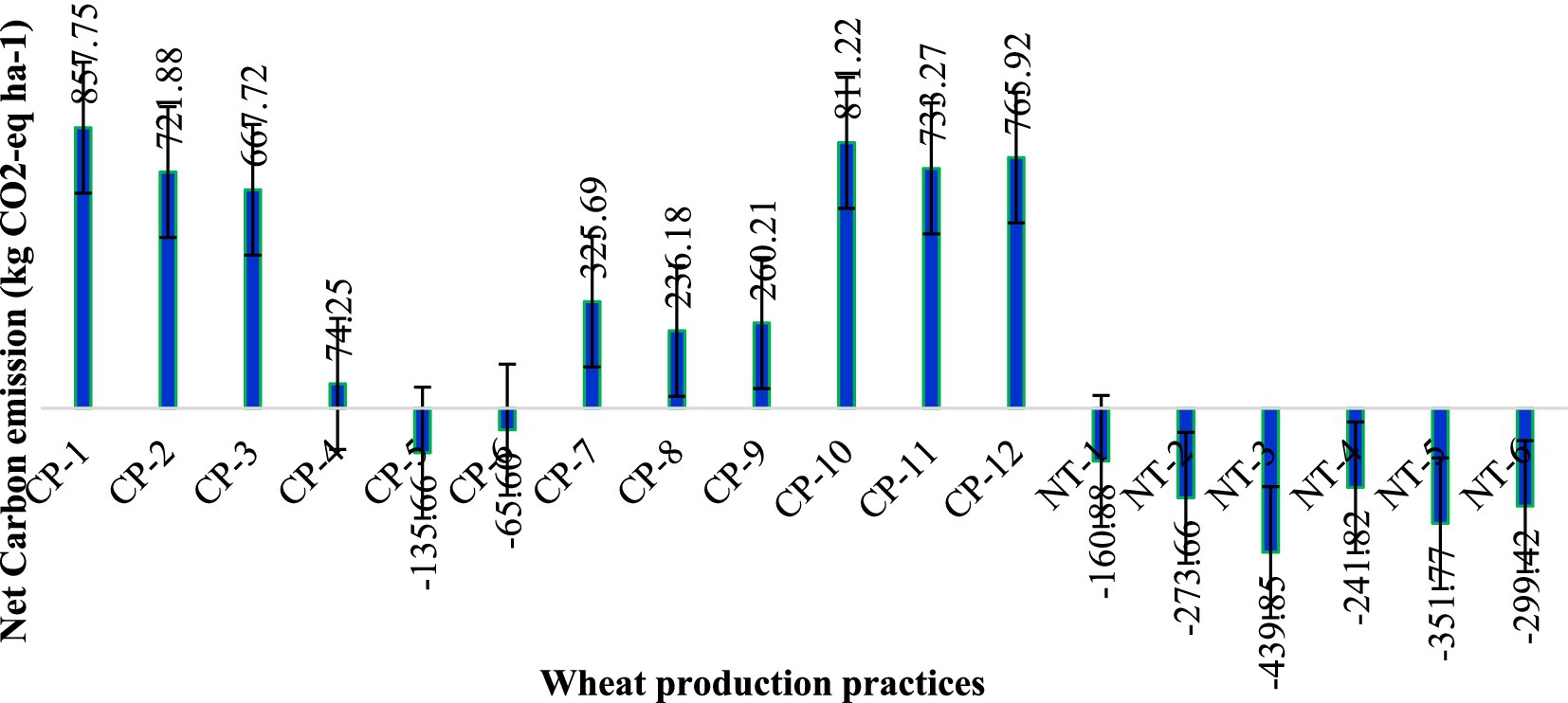- 1Dr. Rajendra Prasad Central Agricultural University, Samastipur, India
- 2ICAR - Research Complex for Eastern Region, Patna, India
Wheat, the second most cultivated crop globally after rice, is a major source of food and nutrition but also contributes significantly to greenhouse gas (GHG) emissions. In the context of climate change, it is important to evaluate cultivation practices not only for their productivity but also for their environmental sustainability. This study assessed conventional tillage and no-tillage wheat production systems in Bihar, India, focusing on CO₂-equivalent emissions, energy use, carbon offset potential, and the carbon sustainability index (CSI). Total GHG emissions from agricultural inputs ranged from 1745.66 to 2239.27 kg CO₂-eq ha−1, with indirect energy sources being the largest contributors in several no-tillage variants. Among the systems studied, NT-6 recorded the highest carbon offset (2597.12 kg CO₂-eq ha−1), while NT-3 achieved the lowest net carbon emission (16.76 kg CO₂-eq ha−1). Conventional practices such as CP-12 were more emission-intensive and heavily dependent on non-renewable energy, whereas no-tillage systems consistently showed lower emissions, higher carbon efficiency, and improved sustainability. The maximum CSI value (0.079) was obtained under NT-4, while CP-1 had the lowest (−0.363). These results demonstrate that no-tillage is not only a low-emission option but also a more energy-efficient and sustainable production system that aligns with climate-smart agriculture. The findings provide evidence-based guidance for policymakers, planners, and farmers to adopt conservation practices that enhance wheat productivity while reducing the environmental footprint, thereby supporting climate change mitigation and long-term agricultural sustainability.
1 Introduction
India, the world’s second-largest wheat producer after China, is set to achieve a record wheat production of 114 million tonnes in 2023–24, surpassing the previous year’s 110.55 million tonnes (Anonymous, 2023). While Uttar Pradesh leads in total wheat production, Punjab records the highest productivity. The diverse agro-climatic conditions and varying farming practices across the wheat growing regions play a decisive role in influencing the wheat production and productivity. Several factors such as the adoption of farm machinery, fuel consumption for tillage, irrigation harvesting, fertilizer usage plant protection and chemical application contribute to varying levels of carbon emissions and footprints across various regions of the country. Common wheat cultivation practices in India include direct seeding using zero-tillage machines, sowing after tillage with rotavators disc harrows, and surface seeding in standing crops (Calegari et al., 2008). The choice of cultivation practices directly influence machinery use, fuel consumption, energy efficiency, and the associated carbon emissions.
Climate change, primarily driven by anthropogenic greenhouse gas (GHG) emissions, presents a significant global challenge. Carbon dioxide (CO2), methane (CH4), and nitrous oxide (N2O) are the top three GHGs contributing to this issue (Stocker et al., 2013; Nayak et al., 2023). Agricultural activities are major sources, accounting for 60% of N2O and 50% of CH4 emissions (Smith et al., 2007; Mohammadi et al., 2022). To mitigate climate change and promote sustainable agriculture, it is essential to reduce GHG emissions from agricultural inputs and enhance carbon sequestration in soils and plants (Lal, 2004; Kashyap and Agarwal, 2021; Lal, 2022). Against this backdrop, focused research and development efforts are necessary to explore and implement cleaner wheat production practices and ecological methods aimed at reducing GHG emissions (Lal, 2004).
Researchers have used carbon footprint (CF) analysis to quantitatively evaluate the greenhouse gas (GHG) emissions associated with various products. The CF, a key environmental performance indicator, measures the total GHG emissions and removals expressed in CO2 equivalents (CO2-eq) throughout a product’s life cycle (ISO TS 14067, 2013; Qi et al., 2008; Zhao et al., 2014). For agricultural products, the CF includes GHG emissions from agricultural inputs and non-CO2 GHG emissions from soils due to field operations like tillage, fertilization, and harvesting. Numerous studies have assessed the CF of agricultural products globally (Dubey and Lal, 2009; Cheng et al., 2015; Gahlot et al., 2020). Life Cycle Assessment (LCA) is a widely used methodology for evaluating the CF of major crop products, assessing their environmental impacts from raw material extraction to the farm gate (Hillier et al., 2009; Dan et al., 2017; Holka, 2020). Optimizing agricultural practices such as tillage and fertilization-based on CF evaluations, can help mitigate climate change by reducing GHG emissions. Recent studies have investigated CFs for field crops under diverse agricultural practices (Gan et al., 2012a; Gan et al., 2012b; Xue et al., 2014; Holka et al., 2022).
Farming practices exert a significant influence on the CF of agricultural products (Luo et al., 2009; Gan et al., 2011; Gan et al., 2014; Hou et al., 2021). These practices encompass tillage methods (Xue et al., 2014; Zhang et al., 2013; Sørensen et al., 2014), cropping systems (Gan et al., 2011; Pal et al., 2010), and nitrogen fertilizer rates (Gan et al., 2012b; Snyder et al., 2009; Wang Z B, et al., 2015). However, a knowledge gap persists regarding the impact of integrated technologies and various farm management practices on the CF of wheat production in India.
Wheat production in India employs both conventional tillage and no-tillage systems, with the latter gaining increasing prominence due to its environmental advantages (Lenka et al., 2015). In response, the Government of Bihar initiated the Climate Resilient Agriculture Program in 2019, prioritizing no-tillage wheat cultivation as a means to mitigate carbon emissions. Given the dominance of the Indo-Gangetic Plain (IGP) in Indian wheat production, practices farming across Bihar and other IGP regions remain largely consistent.
Conventional tillage involves multiple soil preparation steps such as cultivation, disc harrowing, and rotavating followed by sowing through methods such as broadcasting, seed drilling, and zero-till seed-cum-ferti-drilling. Irrigation is sourced from ponds, canals, or groundwater using motorized and fueled pumps. Chemical inputs, including herbicides and pesticides, are applied with knapsack sprayers. Harvesting is carried out either manually with sickles or mechanically with reaper, reaper binder and combine harvester. No-tillage systems differ mainly in sowing technique, employing zero-till seed-cum-ferti-drills to directly sow seeds into unprepared soil. Other practices, such as irrigation and fertilization, remain similar but may differ in intensity. This study aims to quantify carbon footprints (CFs) across different wheat cultivation scenarios to identify sustainable practices. It evaluates GHG emissions from key agricultural inputs and examines the carbon offset potential, supporting the promotion of low-carbon wheat systems in Bihar, located in the middle Indo-Gangetic Plains.
2 Materials and methods
2.1 Site description
The study considered the emission of Carbon dioxide (CO2) produced during wheat production by different farming practices used in Bihar. A survey was conducted in year 2022–23 to determine CO2 emission from wheat crop cultivation by different practices among the farmers of three different agro-climatic regions of Bihar (Figure 1).
Bihar is divided into three agro-climatic zones viz., Zone I, Zone II, and Zone III. For this study, the districts of Begusarai, Madhepura, and Buxer were purposively selected to represent their respective zones. In these districts, no-tillage (NT) wheat cultivation was promoted under the Climate Resilient Agriculture Project, an initiative by the Government of Bihar aimed at enhancing climate resilience and sustainability in agriculture. Comprehensive data were collected on key wheat production operations, including tillage, sowing techniques, weed and pest management, irrigation practices, nutrient application, and harvesting methods. These data were analyzed across different cultivation practices to assess their effects on carbon emissions and input efficiency.
Table 1 summarizes the distribution of farmers and cropping patterns across the three agro-climatic zones, illustrating regional variations in agricultural practices, resource availability, and adoption of sustainable techniques. These differences highlight the importance of context-specific interventions when promoting no-tillage and other climate-resilient strategies. By examining diverse agro-ecological conditions and management practices, the study aims to identify regionally appropriate approaches that enhance wheat productivity while reducing environmental impact. The findings contribute to the development of sustainable, low-carbon farming systems in Bihar’s varied agricultural landscapes.
A total of 1,168 farmers were interviewed as part of this study, utilizing a semi-structured questionnaire to determine the quantities of various inputs used in wheat production. These inputs included operating hours, fuel and electricity consumption across different operations, seed rates, fertilizer doses, and agro-chemical applications in the various wheat production practices. The data collected provided insights into the resource utilization and management practices of farmers across the selected districts. The detailed breakdown of the various practices, along with the associated operations, is presented in Table 2. This table offers a comprehensive overview of the different wheat production practices implemented by the farmers, enabling a deeper understanding of the input–output relationships and the environmental impact of these practices. The data gathered through this approach is critical for assessing the sustainability and efficiency of wheat farming in Bihar, informing strategies for resource optimization and conservation.
2.2 Carbon emission in wheat production practices
The various wheat production practices in the selected districts are outlined in Table 2, which served as the basis for estimating CO₂ emissions in wheat production. The progression of operations, including tillage, crop establishment, plant protection, harvesting, and threshing, was evaluated across the different practices observed during the survey. The GHG emissions associated with these practices were calculated by analyzing the inputs used, such as labor, chemical fertilizers, seeds, herbicides, pesticides, and the performance of machinery sets used for tillage, harvesting, and threshing. These emissions were determined for each specific practice, as detailed in Table 2. The data provided a comprehensive assessment of the environmental impact of various wheat production systems, helping to identify key sources of greenhouse gas emissions and offering insights into potential areas for improvement in sustainable agricultural practices.
2.3 Estimation of GHG emissions for various practices in wheat production
The study was designed to assess the global warming potential of different wheat production practices by estimating the CO₂-equivalents (CO₂-eq) associated with each practice. This estimation process involved quantifying all greenhouse gas (GHG) emissions and removals throughout the entire life cycle of wheat production. The scope of the investigation encompassed a comprehensive system boundary, which included the entire life cycle—from the use of raw materials as agricultural inputs to the point of wheat production at the farm gate (Figure 2). This approach ensured that all relevant emissions, from input procurement to on-farm production, were considered, providing a thorough understanding of the global warming impact of various wheat farming practices.
Raw materials: Emission by manpower, diesel, chemical fertilizer, herbicides, pesticides, seeds and electricity includes production, transport and use.
Farming practices: Tillage, irrigation, harvesting, threshing, and combine harvesting were all considered in the study as integral operations contributing to the overall carbon emissions in wheat production. For tillage, emissions were calculated from the manufacturing, transport, and use of tractors and associated implements. Similarly, for irrigation, emissions were considered from the production, transport, and use of pumps. Harvesting emissions accounted for the manufacturing and operation of self-propelled reaper-cum-binders, while threshing emissions included those from the manufacturing, transport, and use of tractors and threshers. The emissions from combine harvesters were similarly derived from the manufacturing and operational phases. Additionally, the study took into account emissions associated with the driver and manual labor involved in these operations. The economic lifespan of the machinery was factored into the calculation of carbon emissions related to farm machinery production, ensuring a comprehensive assessment of the environmental impact across the entire equipment lifecycle.
The assessment of non-CO2 greenhouse gas (GHG) emissions encompassed both farm land operations and various agricultural inputs throughout the entire wheat production process. The GHG emissions with consisted of the following components:
1. Production, storage, and transportation of agricultural inputs (such as seeds, fertilizers, pesticides) to the farm gate, along with their subsequent application.
2. Manufacturing and operation of farm machinery, including activities like tillage, irrigation, and harvesting.
A comprehensive assessment of agricultural inputs in wheat production, along with their respective carbon emission (CE) factors, is presented in Table 3. The use of kilograms of CO₂ equivalents as a unit of measurement ensures a direct link to atmospheric CO₂ enrichment, a critical global concern. The CE values for various operations are based on actual quantities used in wheat cultivation, including human labor, seed, pesticides, fertilizers, diesel, machinery, electricity, irrigation water, and post-harvest yield (grain and straw). Table 3 also lists the CO₂ equivalent coefficients for each input and output, facilitating accurate calculation of emissions and sequestration.
Total input equivalents were computed by aggregating all components: labor (h), machinery (kg), diesel (L), irrigation water (m3), electricity (kWh), seed (kg), and fertilizers (kg). Output yields were measured per hectare. The CE for each input was calculated by multiplying its quantity by the corresponding coefficient. Furthermore, operation-wise CE estimations were carried out for each stage of wheat production, enabling precise quantification of emissions linked to specific agricultural activities. This detailed analysis supports the identification of high-emission practices and provides actionable insights for enhancing sustainability in wheat farming.
2.4 Estimation of carbon emission by input in various modes of energy sources
The carbon emission in wheat production was also determined on mode wise energy sources. The criteria are as follows. The mode wise carbon emission was determined by summing the inputs mentioned under their respective categories.
Mode of use:
Direct energy: Human, animal, petrol, diesel, electricity, canal.
Indirect energy: Seeds, fertilizers, farmyard manure, chemicals, machinery.
Nature of source Renewable energy: Human, animal, seeds, farmyard manure, canal.
Non-renewable energy: Petrol, diesel, electricity, chemicals, fertilizers, machinery.
Form of use.
Commercial energy: Petrol, diesel, electricity, chemicals, fertilizers, seeds, machinery.
Non-commercial energy: Human, animal, farmyard manure, canal.
The total GHG emissions during wheat cultivation (CEtotal, kg CO₂-eq ha−1) were estimated by accounting for both emissions from agricultural inputs and nitrous oxide (N₂O) emissions from soil. The latter component was calculated using Equations 1, 2:
where CEinputs represents the indirect GHG emissions associated with agricultural inputs (kg CO₂-eq ha−1); CEN₂O denotes the cumulative direct and indirect N₂O emissions expressed in CO₂ equivalents (kg CO₂-eq ha−1) resulting from nitrogen fertilizer application; Qused(k) is the quantity of the kth agricultural input used in wheat production (kg ha−1), including seed; and αk is the emission factor for each input (kg CO₂-eqkg−1). The emission factors for different inputs are provided in Table 3.
The N₂O emissions from farmland were estimated following the 2006 IPCC Guidelines (IPCC, 2006). Nitrogen fertilizer application was identified as the primary contributor to both direct and indirect soil N₂O emissions. The overall N₂O-related GHG emissions were determined using Equation 3:
where DN₂O is the direct N₂O emission from farmland (kg CO₂-eq ha−1); VN₂O represents the indirect N₂O produced through atmospheric deposition of volatilized nitrogen (NH₃ and NOₓ; kg CO₂-eq ha−1); and LN₂O is the N₂O generated from nitrogen leaching and runoff (kg CO₂-eq ha−1). These components were calculated using Equations 4–6.
Here, Fsn is the amount of nitrogen applied as chemical fertilizer during wheat production (kg N ha−1). EF1 is the emission factor for direct N₂O emissions from nitrogen application (0.01 kg N₂O–N per kg N applied). Ffrac-v is the fraction of applied nitrogen volatilized as NH₃ and NOₓ (0.10 kg NH₃–N and NOₓ–N per kg N applied). EF2 is the emission factor for N₂O emissions from atmospheric deposition of volatilized N (0.01 kg N₂O–N per kg NH₃–N and NOₓ–N). Ffrac-leach represents the fraction of nitrogen lost through leaching and runoff (0.30 kg N per kg N applied). EF3 is the emission factor for N₂O emissions from leaching and runoff (0.0075 kg N₂O–N per kg N lost). The conversion factor 44/28 corresponds to the molecular weight ratio of N₂O to N₂O–N, while 298 is the global warming potential (GWP) of N₂O relative to CO₂ over a 100-year horizon.
2.5 Carbon footprint calculation
The carbon footprint (CF) of wheat production system was calculated by dividing all GHG emissions from agricultural inputs by the grain and straw yield of the wheat. The CF assessment of the wheat production was determined by the Equation 7 (Gan et al., 2012a):
Where, CF is the total Carbon Footprint for each kg of wheat grain yield produced (kg CO2-eq kg−1 ha−1); Y is the wheat yield (kg ha−1); and CEtotal is the total GHG emissions during wheat production (kg CO2-eq ha−1), including GHG emissions from agricultural inputs.
2.6 Potential carbon offset
Carbon offset was calculated based on biomass produced. The carbon offset by wheat straw was taken only biomass straw collected in various practices (Table 1). In practices NT-2, NT-4, CP-5, CP-8 and CP-12, wheat straw was not collected as per survey but for calculation of carbon offset, the wheat straw was taken into account. Plant carbon content was assumed at 45% of dry biomass (FAO, 2020). Carbon was converted to CO₂ using the 44/12 molecular weight ratio (IPCC, 2006, 2019). Straw-derived carbon stabilization was estimated at 30%, consistent with IPCC, 2006 guidelines and long-term field studies, representing potential carbon offset through soil organic carbon sequestration.
2.7 Net carbon emission
Net carbon emission was calculated to identify which practices contributed to carbon emissions or carbon offset. The positive value shows the carbon emission and negative values shows carbon offset. Net carbon emission by various practices was calculated by following formula.
Carbon emission per hectare = Carbon emission by different inputs–Carbon offset by straw produce.
2.8 Carbon sustainability index
The carbon sustainability index was estimated based on total CE emission, i.e., input and total carbon offset, i.e., output. The CE emissions was also included the direct N2O emissions related to application of chemical fertilizer (Singh et al., 2020). The CSI was calculated by Equation 8.
2.9 Statistical analysis
The suitability for principal component analysis was determined using the Kaiser-Meyer-Olkin (KMO) Test. Principal components analysis (PCA) and statistical analysis were performed using SPSS 2021 software for carbon emission.
3 Results
3.1 Greenhouse gas emissions from agricultural inputs
Figure 3 presents a comprehensive assessment of greenhouse gas (GHG) emissions resulting from various agricultural inputs across different wheat production systems. The analysis clearly indicates that no-tillage (NT) practices are associated with significantly lower GHG emissions compared to conventional practices (CP) methods. The highest GHG emission was recorded in the CP-3 treatment at 2,330.78 kg CO₂-eq ha−1, whereas the lowest was observed in the NT-2 treatment at 1,745.66 kg CO₂-eq ha−1, illustrating a consistent trend of increased emissions under conventional practices systems (Supplementary Tables S1-S18).
A detailed examination of emission sources reveals that chemical fertilizers including urea, di-ammonium phosphate (DAP), and muriate of potash (MoP) are the primary contributors to total emissions, accounting for approximately 74.07 to 82.66% across all treatments. Diesel fuel use, linked to machinery operation, represents the second-largest source, followed by emissions associated with human labor, seed production, machinery use, and electricity. The category of “chemicals” also includes agrochemicals such as insecticides, herbicides, and pesticides.
These findings emphasize the critical role of nutrient management in emission reduction strategies. Enhancing fertilizer application efficiency and adopting alternative fertilization techniques offer potential pathways to mitigate GHG emissions from wheat cultivation. Furthermore, the comparative analysis highlights the environmental advantages of conservation agriculture practices. No-tillage systems reduce soil disturbance, improve soil carbon sequestration, and minimize diesel consumption, thereby lowering associated GHG emissions. These results advocate for the broader adoption of sustainable agricultural practices to address climate change challenges while sustaining or enhancing crop productivity.
Figure 4 illustrates the operation-wise GHG emissions across different wheat production practices, emphasizing that fertilizer application consistently contributed the highest share of GHG emissions in all treatments. The emissions attributed to chemical applications, including fertilizers, ranged from 69.92 to 77.25% of the total GHG emissions, with the highest contribution observed in treatment CP-3 (Supplementary Tables S1-S18). Among the production practices, GHG emissions were also significant in NT-13, followed sequentially by CP-13, CP-23, and CP-33. Notably, within the chemical application category, treatment NT-5 exhibited the highest percentage contribution (4.84%), while the lowest (4.12%) was recorded in CP-12 (Supplementary Tables S1-S18). Additional GHG emissions were attributed to sowing methods, which varied based on practice, followed by emissions from tillage operations in certain treatments. Irrigation activities consistently ranked as a significant source of emissions across all practices, with threshing and harvesting contributing notably in specific cases. These results highlight the dominant contribution of fertilizer and chemical application as primary emission sources and emphasize the need for precision agriculture techniques and optimized input management to mitigate the environmental impact of wheat production.
The Kaiser-Meyer-Olkin (KMO) test yielded a value of 0.521, indicating that the dataset was marginally suitable for conducting factor analysis. As depicted in Figure 5a, the scree plot analysis revealed the retention of seven factors in the principal component analysis (PCA), aligning with the established criteria for factor selection. Further examination of the eigenvalues showed that only two factors exceeded the threshold value of 1, signifying the presence of two principal components that sufficiently explain the variance within the dataset. These two principal components, as illustrated in Figure 5b, capture the effects of carbon emissions associated with different agricultural inputs. This dimensional reduction not only facilitates a more focused analysis of the emission patterns but also underscores the primary drivers of carbon output, providing a robust framework for targeted mitigation strategies in agricultural systems.
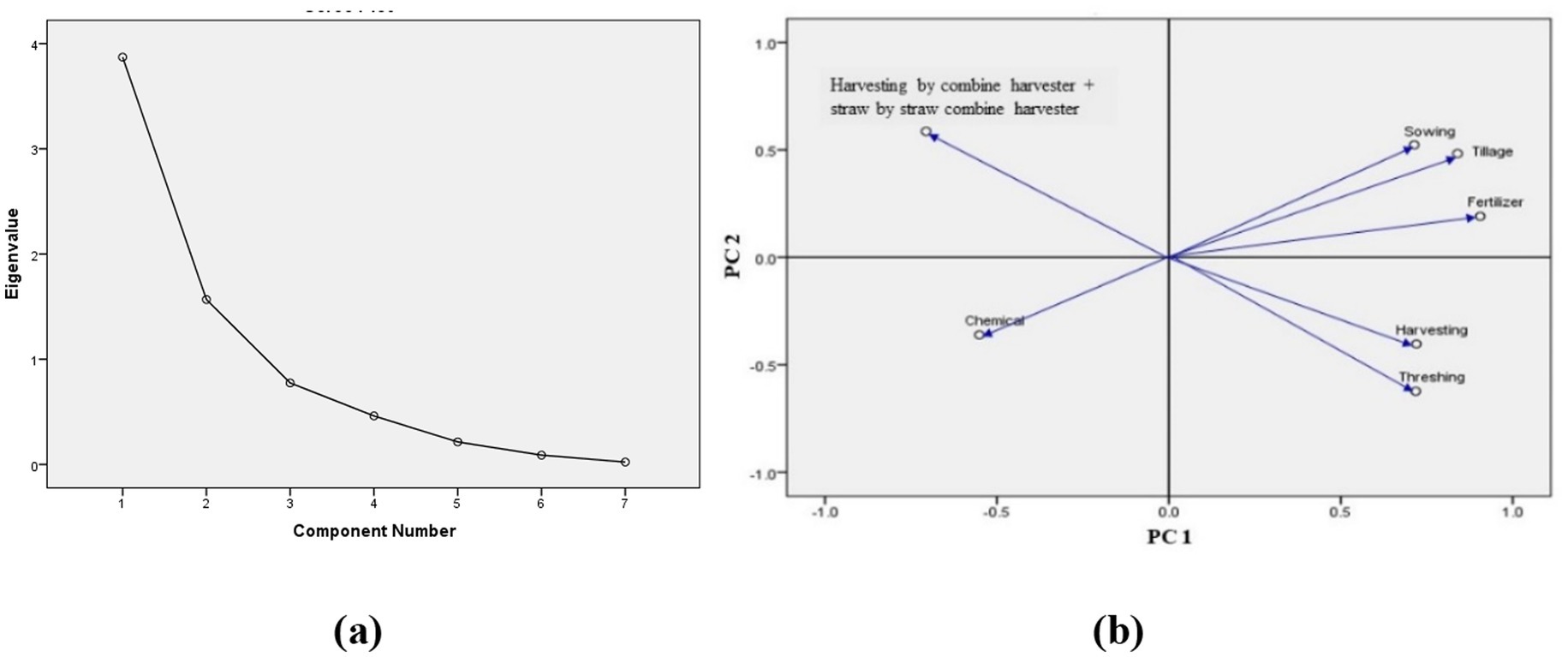
Figure 5. (a) Scree plot average input carbon emission. (b) Principal component analysis of the average input carbon emission in wheat production.
3.2 Source-wise GHG emission
The GHG emissions associated with direct and indirect energy sources, as well as renewable, non-renewable, commercial, and non-commercial sources across various wheat production practices, are detailed in Table 4. Analysis indicates that indirect energy sources accounted for the majority of emissions, contributing between 81 and 88%, with the remaining 12 to 19% originating from direct energy sources. Similarly, non-renewable energy sources were dominant, contributing 89 to 93% of total GHG emissions, underscoring the heavy reliance on fossil fuels and synthetic inputs in these practices. Furthermore, commercial energy sources, such as electricity, fuel, and manufactured inputs, accounted for an overwhelming 91 to 95% of emissions, reflecting the critical role of industrial energy inputs in wheat production. These findings highlight the disproportionate contributions of indirect, non-renewable, and commercial energy sources to the overall carbon footprint, emphasizing the need for transitioning toward renewable energy alternatives, improving energy efficiency, and adopting sustainable agricultural practices to mitigate the environmental impact of wheat cultivation.
The ANOVA results (Table 5) revealed a significant effect of treatment on carbon emission (F = 5.60, p < 0.001), indicating differences among treatments. Replication also showed a significant effect (F = 2.11, p = 0.002). However, the interaction between treatment and replication was non-significant (F = 1.15, p = 0.235), suggesting consistent treatment effects across replications.
Table 6 shows the treatment-wise significance values which indicates that carbon emissions varied considerably among different tillage and management practices. Significant differences (p < 0.05) were mainly observed between non-tillage treatments (NT1–NT5) and conventional practices (CP1–CP12), showing that non-tillage treatments produced significantly lower emissions. Within conventional practices, most pair wise comparisons were non-significant, suggesting relatively similar emission levels across them. In contrast, non-tillage treatments exhibited consistent and statistically significant reductions in emissions compared to conventional practices, highlighting the effectiveness of conservation tillage methods in mitigating greenhouse gas emissions and promoting sustainable agricultural production.
3.3 Carbon footprint of wheat production
Figure 6 illustrates the variations in wheat grain yield and carbon footprint (CF) across different production practices. Grain yield ranged from 3,575 kg ha−1 in CP-1 to a maximum of 5,268 kg ha−1 in NT-3 and NT-6 treatments. A statistically significant difference (p < 0.05) in yield was observed between most treatment pairs, except between NT-3 and NT-6 (Supplementary Tables S1-S18). The CF at the yield scale, which represents the emissions per unit of grain produced, varied from 0.496 to 0.82 kg CO₂-eq kg−1. The highest CF (0.82 kg CO₂-eq kg−1) was recorded for CP-1, correlating with its lowest yield, while the minimum CF (0.56 kg CO₂-eq kg−1) was calculated for NT-3, reflecting its higher productivity and lower emissions per unit. Overall, no-tillage practices utilizing zero-till seed-cum-fertilizer drills demonstrated consistently lower CF values, highlighting their efficiency in reducing emissions while maintaining high yields. These findings underscore the potential of conservation agriculture techniques to enhance both environmental and agronomic performance in wheat production systems.
3.4 Potential carbon offset
The carbon offset was determined for various wheat grain productions as per method described in previous section and shown in Table 7. The highest carbon offset was2907.17 kg CO2-eq ha−1for treatment NT-6. However, the minimum (1866.15) carbon offset was calculated for treatment CP-1.
3.5 Net carbon emission and carbon sustainability index
Figure 7 presents the net carbon emissions across various wheat production practices, calculated using methodologies outlined in the materials and methods section. The analysis reveals that all no tillage treatments showed negative net carbon emission. However, treatment NT-3 and CP-6 exhibited maximum and minimum negative net carbon emissions of −439.85 and −65.60 kg CO₂-eq ha−1, respectively, indicating these practices achieved carbon sequestration exceeding their emissions. In contrast, the highest net carbon emission was recorded in treatment CP-10, with a value of 811.22 kg CO₂-eq ha−1. Negative emission values in no tillage treatments highlight the potential of specific practices to act as carbon sinks by enhancing soil carbon storage and reducing fossil fuel use. Conversely, the elevated emissions in CP-10 underscore the environmental burden associated with conventional tillage practices, primarily due to higher fossil energy inputs and reduced carbon sequestration. These findings emphasize the critical role of sustainable agricultural practices, particularly no-tillage systems, in mitigating greenhouse gas emissions and promoting carbon neutrality in wheat production.
The carbon sustainability index was also determined for various practices of wheat production in Bihar and shown in Table 5. The highest carbon sustainability index (CSI) was 0.13 for NT-3. Whereas, the minimum (−0.29) carbon sustainability index was in CP-1.
4 Discussion
4.1 GHG emissions associated with agricultural inputs
Figure 3 presents source-wise greenhouse gas (GHG) emissions from agricultural inputs across diverse wheat production practices. Chemical inputs—primarily fertilizers, herbicides, pesticides, and insecticides—emerged as the dominant contributors to emissions, consistent with prior findings (Saggar et al., 2009; Muñoz et al., 2010). Diesel fuel was the second-largest source, particularly in highly mechanized operations involving tillage, sowing, harvesting, and straw management using tractor-operated implements. Conversely, conventional practices with reduced mechanization (CP-1 to CP-3) exhibited higher carbon emissions (CE) from human labor. Notably, NT (no-tillage) practices showed lower CE from fertilizers, emphasizing their environmental advantage.
Total GHG emissions ranged from 2,490.24 to 3,075.35 kg CO₂-eq ha−1 (Figure 4), exceeding values reported by Singh et al. (2020), likely due to methodological and contextual differences (Singh et al., 2020; Lenka et al., 2022). Chemical fertilizers remained the highest emission source, especially in traditional systems characterized by over-application, aligning with findings by Xue et al. (2014). NT-1 exhibited the lowest emissions due to adherence to recommended fertilizer doses. Machinery use was the second-largest contributor, including equipment such as combine harvesters and tractor-operated threshers (Singh et al., 2014). On average, 53% of emissions stemmed from nitrogen sources—22% from direct N₂O emissions and indirect nitrogen losses, and 31% from fertilizer production and delivery. Huo et al. also reported that N fertilizer application (EN) was a major contributor in GHG emission for cereal production and it was responsible for 75–84%, followed by mechanical energy emissions (12–21%; Huo et al., 2024).
Herbicides, pesticides, and insecticides were the third-largest contributors, particularly in NT-4 to NT-6, which involved intensive herbicide use. Although smaller in quantity than fertilizers, excessive chemical use poses serious environmental and health concerns, such as groundwater contamination and food residues (Norc, 1994; Wiles et al., 1994). These findings underscore the importance of integrated pest management and precision application technologies to reduce GHG emissions and mitigate ecological risks.
Carbon emissions were significantly lower in NT systems than in conventional tillage, primarily due to reduced fuel consumption, consistent with Sidhu et al. (2015). Reports by Pal et al. (2010) and Bellarby et al. (2008) support NT’s potential to reduce emissions by up to 75%, with irrigation alone accounting for 36% of the reduction (Pal et al., 2010; Bellarby et al., 2008). Principal component analysis (Figure 5B) indicated that irrigation and herbicide use were less influential due to their limited carbon contribution, further reinforcing that reduced mechanization and optimized resource use are central to low-emission wheat production. These findings highlight NT as a viable, sustainable strategy for mitigating the carbon footprint in wheat cultivation.
4.2 Carbon footprint of wheat production
The carbon footprint (CF) per unit grain yield, as illustrated in Figure 6, was found to be the lowest for treatment Z-13 (0.496 CO2-eq), primarily attributed to its high grain yield, including the recovery of left grain during straw harvesting. In contrast, traditional practices, particularly CP-1, exhibited the highest CF (0.820 CO2-eq ha−1), largely due to the significant carbon emissions associated with high-powered machinery and fuel-intensive operations. Notably, all zero-tillage practices demonstrated lower CFs compared to conventional methods. This reduction can be attributed to the elimination of tillage-related emissions and the lower fuel consumption required for sowing and irrigation. The CF of wheat in this study (0.496 CO2-eq ha−1) is considerably lower than those reported by Cheng et al. and Yan et al. (794 kg CO2-eq ha−1 and 3,000 kg CO2-eq ha−1, respectively; Cheng et al., 2015; Yan et al., 2015). Sun et al. also reported that carbon foot print of wheat production in China was (0.26 kg CO2-eq kg−1; Sun et al., 2024). These disparities can be explained by differences in system boundaries, emission factor data sources, and wheat cultivars. When compared to countries like the United States, Canada, and China, India’s carbon footprint per unit yield of wheat is significantly lower, highlighting the potential for sustainable wheat production practices in the region.
4.3 Carbon offset
Table 5 reveals that treatment NT-3exhibited the highest carbon offset, directly correlated with its superior grain and straw yield. Conversely, treatment CP-1 displayed the lowest carbon offset, a consequence of its diminished grain and straw yield. These findings underscore the significant role of crop yield in determining carbon sequestration potential within agricultural systems.
4.4 Net carbon emission and carbon sustainability index
Treatment NT-3 displayed a significant net negative GHG emission of −439.85 kg CO2-eq ha−1 (Figure 7), indicating a substantial carbon sink. This negative value signifies that the treatment sequestered more carbon than it emitted. Notably, NT-3 exhibited the highest carbon offset among all treatments, likely due to its enhanced capacity for carbon sequestration, potentially driven by factors such as increased biomass production and soil organic carbon accumulation. In stark contrast, treatment CP-12 recorded the highest net GHG emission of 1111.24 kg CO2-eq ha−1, primarily attributed to its elevated GHG emissions and reduced carbon offset. The lower grain and straw yield in CP-12 compromised its carbon sequestration potential, leading to a higher net GHG emission. These findings are consistent with previous research by Singh et al., which reported similar trends in GHG emissions and carbon offset across various agricultural treatments (Singh et al., 2020).
The carbon sustainability index (CSI), as depicted in Table 5, was estimated to be positive for all no tillage treatments and CP-5 and CP-6. This positive index suggests a higher degree of carbon sustainability, likely attributable to a combination of increased carbon offset and higher grain yield. The zero-till seed-cum-ferti-drill method (NT) employed in these treatments, as supported by Nandan et al. (2019), has been shown to enhance carbon sequestration in seed and straw while simultaneously reducing GHG emissions. Conversely, treatment CP-1 exhibited the lowest CSI, primarily due to its significantly higher GHG emissions and lower carbon offset, the latter stemming from reduced grain and straw yield. Wheat production practices adhering to CP have consistently demonstrated lower CSI values, as evidenced by Campbell et al. (1995).
5 Conclusion
This study examined 18 wheat production practices in Bihar and demonstrated that cultivation methods vary widely in their carbon footprint and overall sustainability. Conventional tillage systems were consistently more emission-intensive, primarily due to high reliance on chemical fertilizers, diesel consumption, and labor energy. In contrast, no-tillage (NT) practices not only reduced greenhouse gas (GHG) emissions but also enhanced carbon offset potential and carbon sustainability index (CSI), indicating a more balanced relationship between productivity and environmental performance. Beyond lower emissions, NT systems improved resource-use efficiency by reducing fuel demand, minimizing soil disturbance, and lowering dependency on non-renewable energy sources. The findings underline that adoption of NT is not only an environmental choice but also an agronomic strategy that can enhance long-term soil health and economic resilience.
The study further identifies chemical fertilizers, especially urea, DAP, and MoP, as major contributors to emissions, highlighting the need for a shift toward more efficient nutrient management. The promotion of liquid and nano-fertilizers, alongside precision sowing technologies and micro-irrigation systems, offers significant scope for reducing input-related emissions. Additionally, the integration of advanced machinery such as Happy Seeders and Super Seeders can strengthen conservation agriculture by improving sowing efficiency and reducing residue-burning practices.
Overall, the results provide actionable evidence that sustainable intensification of wheat production—through NT, innovative input use, and precision technologies—can substantially reduce the carbon footprint, conserve resources, and support climate-smart agricultural policies. This multi-dimensional approach ensures environmental sustainability while safeguarding farmers’ productivity and profitability.
Data availability statement
The raw data supporting the conclusions of this article will be made available by the authors, without undue reservation.
Author contributions
RP: Data curation, Formal analysis, Investigation, Methodology, Resources, Visualization, Writing – review & editing. SP: Conceptualization, Data curation, Formal analysis, Investigation, Methodology, Software, Validation, Writing – original draft. PS: Resources, Software, Supervision, Writing – review & editing. RJ: Project administration, Resources, Supervision, Writing – review & editing. PJ: Supervision, Validation, Writing – review & editing. AS: Supervision, Writing – review & editing. SK: Investigation, Methodology, Project administration, Writing – original draft.
Funding
The author(s) declare that no financial support was received for the research and/or publication of this article.
Conflict of interest
The authors declare that the research was conducted in the absence of any commercial or financial relationships that could be construed as a potential conflict of interest.
Generative AI statement
The author(s) declare that no Gen AI was used in the creation of this manuscript.
Any alternative text (alt text) provided alongside figures in this article has been generated by Frontiers with the support of artificial intelligence and reasonable efforts have been made to ensure accuracy, including review by the authors wherever possible. If you identify any issues, please contact us.
Publisher’s note
All claims expressed in this article are solely those of the authors and do not necessarily represent those of their affiliated organizations, or those of the publisher, the editors and the reviewers. Any product that may be evaluated in this article, or claim that may be made by its manufacturer, is not guaranteed or endorsed by the publisher.
Supplementary material
The Supplementary material for this article can be found online at: https://www.frontiersin.org/articles/10.3389/fsufs.2025.1661999/full#supplementary-material
References
Anonymous. (2023). Economic survey of Bihar 2022–23: Ministry of Finance, Government of Bihar, Patna, Bihar, India.
Bellarby, J., Foereid, B., Hastings, A., and Smith, P. (2008). Cool farming: climate impacts of agriculture and mitigation potential. Greenpeace Int. 22:2008.
Calegari, A., Hargrove, W. L., Rheinheimer, D. D. S., Ralisch, R., Tessier, D., deTourdonnet, S., et al. (2008). Impact of long-term no-tillage and cropping system management on soil organic carbon in an Oxisol: a model for sustainability. Agron. J. 100, 1013–1019. doi: 10.2134/agronj2007.0121
Campbell, C. A., McConkey, B. G., Zenter, R. P., Dyck, F. B., Selles, F., and Curtin, D. (1995). Carbon sequestration in a brown chernozem as affected by tillage and rotation. Can. J. Soil Sci. 75, 449–458.
Cheng, K., Yan, M., Nayak, D., Pan, G. X., Smith, P., Zheng, J. F., et al. (2015). Carbon footprint of crop production in China: an analysis of National Statistics data. J. Agric. Sci. 153, 422–431. doi: 10.1017/S0021859614000665
Dan, Z., Jianbo, S., Fusuo, Z., Yu, L., and Weifeng, Z. (2017). Carbon footprint of grain production in China. Sci. Rep. 7:4126. doi: 10.1038/s41598-017-04182-x
Dubey, A., and Lal, R. (2009). Carbon footprint and sustainability of agricultural production systems in Punjab, India, and Ohio, USA. J. Crop Improv. 23, 332–e350. doi: 10.1080/15427520902969906
FAO. (2020). The state of food and agriculture 2020. Overcoming water challenges in agriculture. Rome. doi: 10.4060/cb1447en
Gahlot, S., Lin, T. S., Jain, A. K., Roy, S. B., Sehgal, V. K., and Dhakar, R. (2020). Impact of environmental changes and land management practices on wheat production in India. ESD 11, 641–652. doi: 10.5194/esd-11-641-2020
Gan, Y., Liang, C., Campbell, C. A., Zentner, R. P., Lemke, R. L., Wang, H., et al. (2012a). Carbon footprint of spring wheat in response to fallow frequency and soil carbon changes over 25 years on the semiarid Canadian prairie. Eur. J. Agron. 43, 175–184. doi: 10.1016/j.eja.2012.07.004
Gan, Y., Liang, C., Chai, Q., Lemke, R. L., Campbell, C. A., and Zentner, R. P. (2014). Improvingfarming practices reduces the carbon footprint of spring wheat production. Nat. Commun. 5:5012. doi: 10.1038/ncomms6012
Gan, Y., Liang, C., Huang, G. B., Malhi, S. S., Brandt, S. A., and Katepa-Mupondwa, F. (2012b). Carbon footprint of canola and mustard is a function of the rate of Nfertilizer. Int. J. Life Cycle Assess. 17, 58–e68. doi: 10.1007/s11367-011-0337-z
Gan, Y., Liang, C., Wang, X., and Mcconkey, B. (2011). Lowering carbon footprint of durum wheat by diversifying cropping systems. Field Crop Res. 122, 199–206. doi: 10.1016/j.fcr.2011.03.020
Hillier, J., Whittaker, C., Dailey, G., Aylott, M., Casella, E., Richter, G. M., et al. (2009). Greenhouse gas emissions from fourbioenergy crops in England and Wales: integrating spatial estimates of yieldand soil carbon balance in life cycle analyses. Glob. Chang. Biol. 1, 267–e281. doi: 10.1111/j.1757-1707.2009.01021.x
Holka, M. (2020). Assessment of carbon footprint and life cycle costs of winter wheat (TriticumaestivumL.) production in different soil tillage systems. Appl. Ecol. Environ. Res. 18, 5841–5855. doi: 10.15666/aeer/1804_58415855
Holka, M., Kowalska, J., and Jakubowska, M. (2022). Reducing carbon footprint of agriculture—can organic farming help to mitigate climate change? Agriculture 12:1383. doi: 10.3390/agriculture12091383
Hou, L., Yang, Y., Zhang, X., and Jiang, C. (2021). Carbon footprint for wheat and maize production modulated by farm size: a study in the North China plain. Int. J. Clim. Change Strateg. Manag. 13, 302–319. doi: 10.1108/IJCCSM-10-2020-0110
Huo, Y., Mi, G., Zhu, M., Chen, S., Li, J., Hao, Z., et al. (2024). Carbon footprint of farming practices in farmland ecosystems on the north and Northeast China plains. J. Environ. Manag. 354:120378. doi: 10.1016/j.jenvman.2024.120378
IPCC. (2006). 2006 IPCC Guidelines for national greenhouse gas inventories. Institute for global environmental strategies (IGES) for the IPCC.
IPCC. (2019) Climate Change and Land: an IPCC special report on climate change, desertification, land degradation, sustainable land management, food security, and greenhouse gas fluxes in terrestrial ecosystems. P. R. Shukla, J. Skea, E. Calvo Buendia, V. Masson-Delmotte, H.-O. Pörtner, and D. C. Roberts (eds.).
ISO TS 14067. (2013). Greenhouse gases-carbon footprint of products requirements and guidelines for quantification and communication. Geneva, Switzerland: International Organization for Standardization.
Kashyap, D., and Agarwal, T. (2021). Carbon footprint and water footprint of rice and wheat production in Punjab, India. Agric. Syst. 186:102959. doi: 10.1016/j.agsy.2020.102959
Lal, R. (2004). Carbon emission from farm operations. Environ. Int. 30, 981–990. doi: 10.1016/j.envint.2004.03.005
Lal, R. (2022). Reducing carbon footprints of agriculture and food systems. Carbon footprints 1:1–19. doi: 10.20517/cf.2022.05
Lenka, S., Lenka, N. K., Rao, A. S., Raghuwanshi, J., Singh, B., Saha, J. K., et al. (2022). Tillage and nutrient management influence net global warming potential and greenhouse gas intensity in soybean-wheat cropping system. Indian J. Exp. Biol. 60, 207–214. doi: 10.56093/ijas.v84i2.38047
Lenka, S., Lenka, N. K., Singh, R. C., Raghuwanshi, J., Singh, R. K., and Lakaria, B. (2015). Tillage and manure induced changes in carbon storage and carbon management index in soybean-wheat system of vertisols. National Academy Sci. Letter. 38, 461–464. doi: 10.1007/s40009-015-0384-2
Li, J., Luo, Z., Wang, Y., Li, H., Xing, H., Wang, L., et al. (2019). Optimizing nitrogen and residue management to reduce GHG emissions while maintaining crop yield: a case study in a mono-cropping system of Northeast China. Sustainability 11:5015. doi: 10.3390/su11185015
Luo, Q., Bellotti, W., Williams, M., and Wang, E. (2009). Adaptation to climate change of wheat growing in South Australia: analysis of management and breeding strategies. Agric. Ecosyst. Environ. 129, 261–267. doi: 10.1016/j.agee.2008.09.010
Mohammadi, A., Venkatesh, G., EskandariS,, and Rafiee, S. (2022). Eco-efficiency analysis to improve environmental performance of wheat production. Agriculture 12:1031. doi: 10.3390/agriculture12071031
Muñoz, C., Paulino, L., and MonrealC, Z. E. (2010). Greenhouse gas (CO2and N2O) emissions from soils: a review. Chil. J. Agr. Res. 70, 485–497. doi: 10.4067/S0718-5839201000030001
Nandan, R., Singh, V., Singh, S. S., Kumar, V., Hazra, K. K., Nath, C. P., et al. (2019). Impact of conservation tillage in rice-basedcropping systems on soil aggregation, carbon pools and nutrients. Geoderma 340, 104–114. doi: 10.1016/j.geoderma.2019.01.001
Nayak, A. K., Tripathi, R., Debnath, M., Swain, C. K., Dhal, B., KumarSV,, et al. (2023). Carbon and water footprints of major crop production in India. Pedosphere 33, 448–462. doi: 10.1016/j.pedsph.2022.06.045
Norc (1994). General social surveys, 1972–1994: Cumulative codebook. Chicago, IL: University of Chicago, National Opinion Research Center.
Pal, S, Sekar, I, and Kar, A. (2010). Environmental impact of resource conservation technology: the case of zero-tillage in the rice-wheat system of South Asia. Report to the CGIAR standing panel on impact assessment. http://impact.cgiar.org/sites/default/files/docs/ICAR_EIA_2010.pdf.dt.
Qi, J. Y., Yang, S. T., Xue, J. F., Liu, C. X., Du, T. Q., Hao, J. P., et al. (2008). Response of carbon footprint of spring maize production to cultivation patterns in the loess plateau. China. J. Cleaner Production 187, 525–536. doi: 10.1016/j.jclepro.2018.02.184
Saggar, S., Luo, J., Giltrap, D., and Maddena, M. (2009). “Nitrous oxide emissions from temperate grasslands: processes, measurements, modelling and mitigation” in Nitrousoxide emissions research progress. EnvironmentalScience, engineering and technology series. eds. A. I. Sheldon and E. P. Barnhart (New York, USA: NovaScience Publishers), 1–66.
Sidhu, H. S., Singh, M., Singh, Y., Blackwell, J., Lohan, S. K., Humphreys, E., et al. (2015). Development and evaluation of the turbo happy seeder forsowing wheat into heavy rice residues in NW India. Field Crop Res. 184, 201–212. doi: 10.1016/j.fcr.2015.07.025
Singh, P., Singh, G., and Sodhi, G. P. S. (2020). Energy and carbon footprints of wheat establishment following different rice residue management strategies Vis-_a-Vis conventional tillage coupled with rice residue burning in North-Western India. Energy 200:117554. doi: 10.1016/j.energy.2020.117554
Singh, R. C., Lenka, S., and Singh, C. D. (2014). Conservation tillage and manure effect on soil aggregation, yield and energy requirement for wheat in vertisols. Indian J. Agric. Sci. 84, 267–271.
Smith, P., Martino, D., Cai, Z., Gwary, D., Janzen, H., Kumar, P., et al. (2007). Policy and technological constraints to implementationof greenhouse gas mitigation options in agriculture. Agric. Ecosyst. Environ. 118, 6–28. doi: 10.1016/j.agee.2006.06.006
Snyder, C. S., Bruulsema, T. W., Jensen, T. L., and Fixen, P. E. (2009). Review of greenhouse gas emissions from crop production systems and fertilizer management effects. Agric. Ecosyst. Environ. 133, 247–266. doi: 10.1016/j.agee.2009.04.021
Sørensen, C. G., Halberg, N., Oudshoorn, F. W., Petersen, B. M., and Dalgaard, R. (2014). Energy inputs and GHG emissions of tillagesystems. Biosyst. Eng. 120, 2–14. doi: 10.1016/j.biosystemseng.2014.01.004
Stocker, T., Qin, D., Plattner, G., Tignor, M., Allen, S., Boschung, J., et al. (2013). Climate change 2013: the physical science Basis. Contribution of working group I to the fifth assessment report of the IntergovernmentalPanel on climate change. Cambridge, United Kingdom and New York, NY, USA: Cambridge University Press, 33–115.
Sun, T., Li, H., Wang, C., Li, R., Zhao, Z., Guo, B., et al. (2024). The carbon footprint and influencing factors of the Main grain crops in the North China plain. Agronomy 14:1720. doi: 10.3390/agronomy14081720
Wang, H., Yang, Y., Zhang, X., and Tian, G. (2015). Carbon footprint analysis for mechanization of maize production based on life cycle assessment: a case study in Jilin Province, China. Sustainability 7, 15772–15784. doi: 10.3390/su71115772
Wang, Z. B., Wen, X. Y., Zhang, H. L., Lu, X. H., and Chen, F. (2015). Net energy yield and carbon footprint of summer corn under different N fertilizer rates in the North China plain. J. Integr. Agric. 14:1534, –e1541. doi: 10.1016/S2095-3119(15)61042-5
West, T. O., and Marland, G. (2002). A synthesis of carbon sequestration, carbon emissions, and net carbon flux in agriculture: comparing tillage practices in the United States. Agric. Ecosyst. Environ. 91, 217–232. doi: 10.1016/S0167-8809(01)00233-X
Wiles, R., Cohen, B., Campbell, C., and Alderkin, S. (1994). Tap water blues: Herbicides in drinking water. Washington, DC: Environmental Working Group and Physicians for Social Responsibility.
Xue, J. F., Liu, S. L., Chen, Z. D., Chen, F., Lal, R., Tang, H. M., et al. (2014). Assessment of carbon sustainability under different tillage systems in a double rice cropping system in southern China. Int. J. Life Cycle Assess. 19, 1581–1592. doi: 10.1007/s11367-014-0768-4
Yan, M., Cheng, K., Luo, T., Yan, Y., Pan, G., and Rees, R. M. (2015). Carbon footprint of grain crop production in China – based on farm survey data. J. Clean. Prod. 104, 130–138. doi: 10.1016/j.jclepro.2015.05.058
Zhang, M. Y., Wang, F. J., Chen, F., Malemela, M. P., and Zhang, H. L. (2013). Comparison ofthree tillage systems in the wheat-maize system on carbon sequestration in theNorth China plain. J. Clean. Prod. 54, 101–e107. doi: 10.1016/j.jclepro.2013.04.033
Zhao, G., Bryan, B. A., and Song, X. (2014). Sensitivity and uncertainty analysis of the APSIM-wheat model: interactions between cultivar, environmental, and management parameters. Ecol. Model. 279, 1–11. doi: 10.1016/j.ecolmodel.2014.02.003
Keywords: carbon footprint, life cycle assessment, greenhouse gas emissions, environmental impact, zero tillage
Citation: Pal R, Patel SK, Sundaram PK, Jha RK, Jeet P, Sattar A and Kumar S (2025) GHG emissions and carbon footprint in wheat cultivation practices in Bihar state of India. Front. Sustain. Food Syst. 9:1661999. doi: 10.3389/fsufs.2025.1661999
Edited by:
Sangeeta Lenka, Indian Institute of Soil Science (ICAR), IndiaReviewed by:
Bidisha Chakrabarti, Indian Agricultural Research Institute (ICAR), IndiaS. Katina Chachei, Banaras Hindu University, India
Copyright © 2025 Pal, Patel, Sundaram, Jha, Jeet, Sattar and Kumar. This is an open-access article distributed under the terms of the Creative Commons Attribution License (CC BY). The use, distribution or reproduction in other forums is permitted, provided the original author(s) and the copyright owner(s) are credited and that the original publication in this journal is cited, in accordance with accepted academic practice. No use, distribution or reproduction is permitted which does not comply with these terms.
*Correspondence: Sanjay Kumar Patel, c3BwaWFyaUBnbWFpbC5jb20=Prem Kumar Sundaram, cHJlbS5rLnN1bmRhcmFtQGdtYWlsLmNvbQ==
 Ram Pal
Ram Pal Sanjay Kumar Patel
Sanjay Kumar Patel Prem Kumar Sundaram
Prem Kumar Sundaram Ratnesh Kumar Jha
Ratnesh Kumar Jha Pawan Jeet
Pawan Jeet Abdus Sattar1,2
Abdus Sattar1,2 Sanjay Kumar
Sanjay Kumar